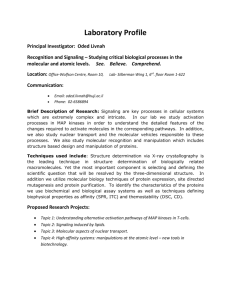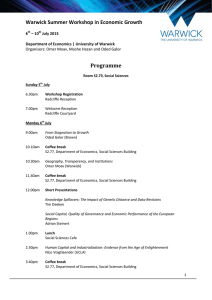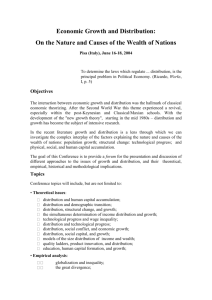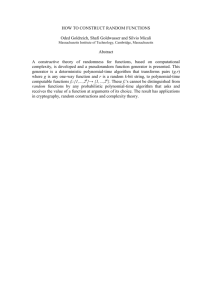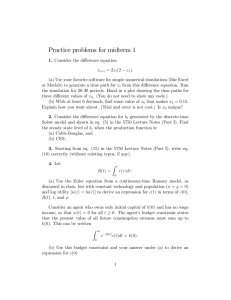Human Evolution and Economic Development Oded Galor July 5, 2015 Evolution and Growth
advertisement
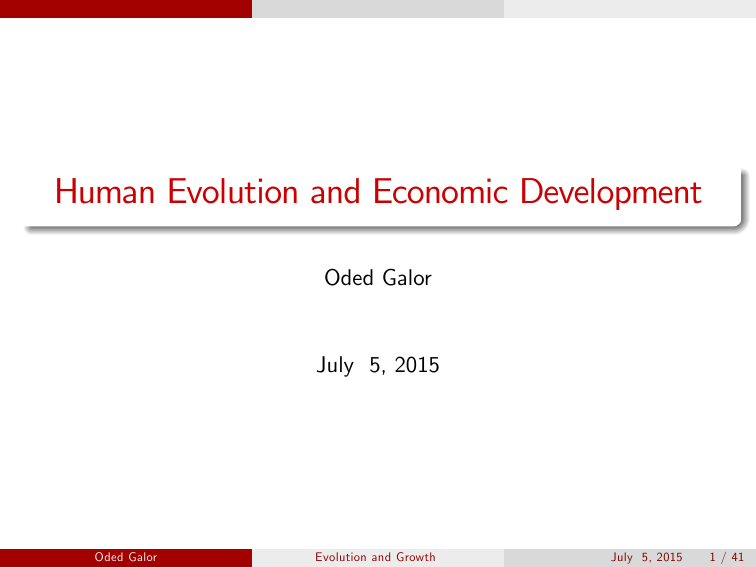
Human Evolution and Economic Development Oded Galor July 5, 2015 Oded Galor Evolution and Growth July 5, 2015 1 / 41 Evolutionary Growth Theory Evolutionary Growth Theory Captures the coevolution of human traits and the growth process in the course of human history Oded Galor Evolution and Growth July 5, 2015 2 / 41 Evolutionary Growth Theory Evolutionary Growth Theory Captures the coevolution of human traits and the growth process in the course of human history The e¤ect of the economic environment on the evolutionary processes in the composition of human traits Oded Galor Evolution and Growth July 5, 2015 2 / 41 Evolutionary Growth Theory Evolutionary Growth Theory Captures the coevolution of human traits and the growth process in the course of human history The e¤ect of the economic environment on the evolutionary processes in the composition of human traits The impact of the evolution in the composition of human traits on the growth process Oded Galor Evolution and Growth July 5, 2015 2 / 41 Evolutionary Growth Theory Evolutionary Growth Theory Captures the coevolution of human traits and the growth process in the course of human history The e¤ect of the economic environment on the evolutionary processes in the composition of human traits The impact of the evolution in the composition of human traits on the growth process Galor and Moav (QJE, 2002) Oded Galor Evolution and Growth July 5, 2015 2 / 41 Evolutionary Growth Theory Main Hypothesis The coevolution of human traits and the growth process is critical for the understanding of the transition from stagnation to growth Oded Galor Evolution and Growth July 5, 2015 3 / 41 Evolutionary Growth Theory Main Hypothesis The coevolution of human traits and the growth process is critical for the understanding of the transition from stagnation to growth During the Malthusian epoch the composition of human traits that were critical for the growth process had not been stationary Oded Galor Evolution and Growth July 5, 2015 3 / 41 Evolutionary Growth Theory Main Hypothesis The coevolution of human traits and the growth process is critical for the understanding of the transition from stagnation to growth During the Malthusian epoch the composition of human traits that were critical for the growth process had not been stationary The Malthusian pressure a¤ected the size and the composition of the population Oded Galor Evolution and Growth July 5, 2015 3 / 41 Evolutionary Growth Theory Main Hypothesis The coevolution of human traits and the growth process is critical for the understanding of the transition from stagnation to growth During the Malthusian epoch the composition of human traits that were critical for the growth process had not been stationary The Malthusian pressure a¤ected the size and the composition of the population Hereditary physical and cognitive traits that generated higher income Oded Galor Evolution and Growth July 5, 2015 3 / 41 Evolutionary Growth Theory Main Hypothesis The coevolution of human traits and the growth process is critical for the understanding of the transition from stagnation to growth During the Malthusian epoch the composition of human traits that were critical for the growth process had not been stationary The Malthusian pressure a¤ected the size and the composition of the population Hereditary physical and cognitive traits that generated higher income Higher reproductive success Oded Galor Evolution and Growth July 5, 2015 3 / 41 Evolutionary Growth Theory Main Hypothesis The coevolution of human traits and the growth process is critical for the understanding of the transition from stagnation to growth During the Malthusian epoch the composition of human traits that were critical for the growth process had not been stationary The Malthusian pressure a¤ected the size and the composition of the population Hereditary physical and cognitive traits that generated higher income Higher reproductive success Become more prevalent in the population Oded Galor Evolution and Growth July 5, 2015 3 / 41 Evolutionary Growth Theory Main Hypothesis The coevolution of human traits and the growth process is critical for the understanding of the transition from stagnation to growth During the Malthusian epoch the composition of human traits that were critical for the growth process had not been stationary The Malthusian pressure a¤ected the size and the composition of the population Hereditary physical and cognitive traits that generated higher income Higher reproductive success Become more prevalent in the population The forces of natural selection Oded Galor Evolution and Growth July 5, 2015 3 / 41 Evolutionary Growth Theory Main Hypothesis The coevolution of human traits and the growth process is critical for the understanding of the transition from stagnation to growth During the Malthusian epoch the composition of human traits that were critical for the growth process had not been stationary The Malthusian pressure a¤ected the size and the composition of the population Hereditary physical and cognitive traits that generated higher income Higher reproductive success Become more prevalent in the population The forces of natural selection Increased the representation of traits that were complementary to the growth process Oded Galor Evolution and Growth July 5, 2015 3 / 41 Evolutionary Growth Theory Main Hypothesis The coevolution of human traits and the growth process is critical for the understanding of the transition from stagnation to growth During the Malthusian epoch the composition of human traits that were critical for the growth process had not been stationary The Malthusian pressure a¤ected the size and the composition of the population Hereditary physical and cognitive traits that generated higher income Higher reproductive success Become more prevalent in the population The forces of natural selection Increased the representation of traits that were complementary to the growth process Reinforced the growth process Oded Galor Evolution and Growth July 5, 2015 3 / 41 Evolutionary Growth Theory Main Hypothesis The coevolution of human traits and the growth process is critical for the understanding of the transition from stagnation to growth During the Malthusian epoch the composition of human traits that were critical for the growth process had not been stationary The Malthusian pressure a¤ected the size and the composition of the population Hereditary physical and cognitive traits that generated higher income Higher reproductive success Become more prevalent in the population The forces of natural selection Increased the representation of traits that were complementary to the growth process Reinforced the growth process stimulated the take-o¤ from an epoch of stagnation to sustained growth Oded Galor Evolution and Growth July 5, 2015 3 / 41 Evolutionary Growth Theory Selection of Predisposition Towards Child Quality The rise of the reward for human capital has increased the evolutionary optimal investment in o¤spring’s quality Oded Galor Evolution and Growth July 5, 2015 4 / 41 Evolutionary Growth Theory Selection of Predisposition Towards Child Quality The rise of the reward for human capital has increased the evolutionary optimal investment in o¤spring’s quality The evolution of the human brain and the complementarity between brain capacity and investment in human capital Oded Galor Evolution and Growth July 5, 2015 4 / 41 Evolutionary Growth Theory Selection of Predisposition Towards Child Quality The rise of the reward for human capital has increased the evolutionary optimal investment in o¤spring’s quality The evolution of the human brain and the complementarity between brain capacity and investment in human capital Increased economic complexity in the course of the Neolithic Revolution Oded Galor Evolution and Growth July 5, 2015 4 / 41 Evolutionary Growth Theory Selection of Predisposition Towards Child Quality The rise of the reward for human capital has increased the evolutionary optimal investment in o¤spring’s quality The evolution of the human brain and the complementarity between brain capacity and investment in human capital Increased economic complexity in the course of the Neolithic Revolution The Malthusian pressure increased the representation of human traits that were complementary to investment in human capital Oded Galor Evolution and Growth July 5, 2015 4 / 41 Evolutionary Growth Theory Selection of Predisposition Towards Child Quality The rise of the reward for human capital has increased the evolutionary optimal investment in o¤spring’s quality The evolution of the human brain and the complementarity between brain capacity and investment in human capital Increased economic complexity in the course of the Neolithic Revolution The Malthusian pressure increased the representation of human traits that were complementary to investment in human capital Preference for child quality (Galor-Moav, 2002) Oded Galor Evolution and Growth July 5, 2015 4 / 41 Evolutionary Growth Theory Selection of Predisposition Towards Child Quality The rise of the reward for human capital has increased the evolutionary optimal investment in o¤spring’s quality The evolution of the human brain and the complementarity between brain capacity and investment in human capital Increased economic complexity in the course of the Neolithic Revolution The Malthusian pressure increased the representation of human traits that were complementary to investment in human capital Preference for child quality (Galor-Moav, 2002) Higher life expectancy (Galor-Moav, 2005, 2007) Oded Galor Evolution and Growth July 5, 2015 4 / 41 Evolutionary Growth Theory Selection of Predisposition Towards Child Quality The rise of the reward for human capital has increased the evolutionary optimal investment in o¤spring’s quality The evolution of the human brain and the complementarity between brain capacity and investment in human capital Increased economic complexity in the course of the Neolithic Revolution The Malthusian pressure increased the representation of human traits that were complementary to investment in human capital Preference for child quality (Galor-Moav, 2002) Higher life expectancy (Galor-Moav, 2005, 2007) Moderate fecundity (Galor-Klemp, 2015) Oded Galor Evolution and Growth July 5, 2015 4 / 41 Evolutionary Growth Theory Selection of Predisposition Towards Child Quality The rise of the reward for human capital has increased the evolutionary optimal investment in o¤spring’s quality The evolution of the human brain and the complementarity between brain capacity and investment in human capital Increased economic complexity in the course of the Neolithic Revolution The Malthusian pressure increased the representation of human traits that were complementary to investment in human capital Preference for child quality (Galor-Moav, 2002) Higher life expectancy (Galor-Moav, 2005, 2007) Moderate fecundity (Galor-Klemp, 2015) Entrepreneurial spirit (Galor-Michalopoulos, 2012) Oded Galor Evolution and Growth July 5, 2015 4 / 41 Theory The Benchmark Model – Galor-Moav (QJE 2002) Overlapping-generations economy Oded Galor Evolution and Growth July 5, 2015 5 / 41 Theory The Benchmark Model – Galor-Moav (QJE 2002) Overlapping-generations economy t = 0, 1, 2, 3... Oded Galor Evolution and Growth July 5, 2015 5 / 41 Theory The Benchmark Model – Galor-Moav (QJE 2002) Overlapping-generations economy t = 0, 1, 2, 3... One homogeneous good Oded Galor Evolution and Growth July 5, 2015 5 / 41 Theory The Benchmark Model – Galor-Moav (QJE 2002) Overlapping-generations economy t = 0, 1, 2, 3... One homogeneous good 2 factors of production: Labor (measured in e¢ ciency units) Land Oded Galor Evolution and Growth July 5, 2015 5 / 41 Theory Factor Supply Land is …xed over time Surface of planet earth Oded Galor Evolution and Growth July 5, 2015 6 / 41 Theory Factor Supply Land is …xed over time Surface of planet earth E¢ ciency units of labor evolves endogenously Determined by households’ decisions about the number and level of human capital of their children Oded Galor Evolution and Growth July 5, 2015 6 / 41 Theory The Main Elements Main Elements The Malthusian Structure The Darwinian Structure Sources of Technological Progress Origins of Human Capital Formation Triggers of the Demographic Transition Oded Galor Evolution and Growth July 5, 2015 7 / 41 Theory The Main Elements The Malthusian Structure A subsistence consumption constraint Oded Galor Evolution and Growth July 5, 2015 8 / 41 Theory The Main Elements The Malthusian Structure A subsistence consumption constraint Positive e¤ect of income on population y " =) L " Oded Galor Evolution and Growth July 5, 2015 8 / 41 Theory The Main Elements The Malthusian Structure A subsistence consumption constraint Positive e¤ect of income on population y " =) L " Fixed factor of production – Land L " =) APL # =) y # Oded Galor Evolution and Growth July 5, 2015 8 / 41 Theory The Main Elements The Malthusian Structure A subsistence consumption constraint Positive e¤ect of income on population y " =) L " Fixed factor of production – Land L " =) APL # =) y # Output per capita ‡uctuates (with a negligible trend) around a constant level in the long-run Re‡ecting diminishing returns to labor & positive e¤ect of income on population Oded Galor Evolution and Growth July 5, 2015 8 / 41 Theory The Main Elements Production The output produced in period t Yt = Ht1 Ht At X Oded Galor α ( At X ) α e¢ ciency units of labor technological level land Evolution and Growth July 5, 2015 9 / 41 Theory The Main Elements Production The output produced in period t Yt = Ht1 Ht At X α ( At X ) α e¢ ciency units of labor technological level land Output per e¢ ciency units of labor at time t yt = xtα xt Oded Galor (At X )/Htt e¤ective resources per worker Evolution and Growth July 5, 2015 9 / 41 Theory The Main Elements The Malthusian Structure – E¤ects of Technological Progress Very short-run (for a given population): At " =) yt " (above ȳ ) Oded Galor Evolution and Growth July 5, 2015 10 / 41 Theory The Main Elements The Malthusian Structure – E¤ects of Technological Progress Very short-run (for a given population): At " =) yt " (above ȳ ) Short-run (initial adjustment of population): yt " =) Lt " Oded Galor Evolution and Growth July 5, 2015 10 / 41 Theory The Main Elements The Malthusian Structure – E¤ects of Technological Progress Very short-run (for a given population): At " =) yt " (above ȳ ) Short-run (initial adjustment of population): yt " =) Lt " Long-run (population reaches a new steady-state): Lt " =) y # (back to ȳ ) Oded Galor Evolution and Growth July 5, 2015 10 / 41 Theory The Main Elements Sources of Technological Progress Average individuals’quality a¤ects technological progress et " Oded Galor =) Evolution and Growth At " July 5, 2015 11 / 41 Theory The Main Elements Sources of Technological Progress Average individuals’quality a¤ects technological progress et " =) At " human capital provides an advantage in adopting and advancing new technologies Oded Galor Evolution and Growth July 5, 2015 11 / 41 Theory The Main Elements Technological Progress gt +1 gt +1 et At + 1 At = ψ ( et ) At rate of tech progress average quality Oded Galor Evolution and Growth July 5, 2015 12 / 41 Theory The Main Elements Technological Progress gt +1 gt +1 et At + 1 At = ψ ( et ) At rate of tech progress average quality ψ0 (et ) > 0; ψ00 (et ) < 0; ψ (0) = 0 The average quality of the population has a positive and diminishing e¤ect on technological progress Oded Galor Evolution and Growth July 5, 2015 12 / 41 Theory The Main Elements Origins of Human Capital Formation The increase in the rate of technological progress increases the demand for human capital Oded Galor Evolution and Growth July 5, 2015 13 / 41 Theory The Main Elements Origins of Human Capital Formation The increase in the rate of technological progress increases the demand for human capital Human capital permits individuals to better cope with the changes in the technological environment Oded Galor Evolution and Growth July 5, 2015 13 / 41 Theory The Main Elements Origins of Human Capital Formation The increase in the rate of technological progress increases the demand for human capital Human capital permits individuals to better cope with the changes in the technological environment The introduction of new technologies is skill-biased in the short-run, although the nature of the technology can be skill-biased or skill-saving in the long run Oded Galor Evolution and Growth July 5, 2015 13 / 41 Theory The Main Elements Human Capital Formation Oded Galor Evolution and Growth July 5, 2015 14 / 41 Theory The Main Elements Human Capital Formation Human capital of an individual who joins the labor force in period t + 1 h t + 1 = h ( et + 1 , g t + 1 ) Oded Galor Evolution and Growth July 5, 2015 14 / 41 Theory The Main Elements Human Capital Formation Human capital of an individual who joins the labor force in period t + 1 h t + 1 = h ( et + 1 , g t + 1 ) et + 1 the individual education level (determined by parental investment, subject to their subsistence constraint, in period t ) gt +1 rate of tech progress Oded Galor Evolution and Growth July 5, 2015 14 / 41 Theory The Main Elements Human Capital Formation h t + 1 = h ( et + 1 , g t + 1 ) he (e, g ) > 0 and hee (e, g ) < 0 HC is increasing (in decreasing rates) in the parental time investment in the education of the child Oded Galor Evolution and Growth July 5, 2015 15 / 41 Theory The Main Elements Human Capital Formation h t + 1 = h ( et + 1 , g t + 1 ) he (e, g ) > 0 and hee (e, g ) < 0 HC is increasing (in decreasing rates) in the parental time investment in the education of the child hg (e, g ) < 0 and hgg (e, g ) > 0 Obsolescence of HC in a changing technological environment Oded Galor Evolution and Growth July 5, 2015 15 / 41 Theory The Main Elements Human Capital Formation h t + 1 = h ( et + 1 , g t + 1 ) he (e, g ) > 0 and hee (e, g ) < 0 HC is increasing (in decreasing rates) in the parental time investment in the education of the child hg (e, g ) < 0 and hgg (e, g ) > 0 Obsolescence of HC in a changing technological environment heg (e, g ) > 0 Education lessens the obsolescence of HC in a changing technological environment Oded Galor Evolution and Growth July 5, 2015 15 / 41 Theory The Main Elements Human Capital Formation h t + 1 = h ( et + 1 , g t + 1 ) he (e, g ) > 0 and hee (e, g ) < 0 HC is increasing (in decreasing rates) in the parental time investment in the education of the child hg (e, g ) < 0 and hgg (e, g ) > 0 Obsolescence of HC in a changing technological environment heg (e, g ) > 0 Education lessens the obsolescence of HC in a changing technological environment h (0, g ) > 0 Basic level of human capital Oded Galor Evolution and Growth July 5, 2015 15 / 41 Theory The Main Elements Human Capital Formation Oded Galor Evolution and Growth July 5, 2015 16 / 41 Theory The Main Elements Human Capital Formation Oded Galor Evolution and Growth July 5, 2015 17 / 41 Theory The Main Elements Triggers of the Demographic Transition The rise in the demand for human capital induces parents to substitute quality for quantity of children Oded Galor Evolution and Growth July 5, 2015 18 / 41 Theory The Main Elements Triggers of the Demographic Transition The rise in the demand for human capital induces parents to substitute quality for quantity of children The rise in income along with the rise in the potential return to human capital generates: Oded Galor Evolution and Growth July 5, 2015 18 / 41 Theory The Main Elements Triggers of the Demographic Transition The rise in the demand for human capital induces parents to substitute quality for quantity of children The rise in income along with the rise in the potential return to human capital generates: An income e¤ect – more income to spend on children Oded Galor Evolution and Growth July 5, 2015 18 / 41 Theory The Main Elements Triggers of the Demographic Transition The rise in the demand for human capital induces parents to substitute quality for quantity of children The rise in income along with the rise in the potential return to human capital generates: An income e¤ect – more income to spend on children Substitution e¤ects Oded Galor Evolution and Growth July 5, 2015 18 / 41 Theory The Main Elements Triggers of the Demographic Transition The rise in the demand for human capital induces parents to substitute quality for quantity of children The rise in income along with the rise in the potential return to human capital generates: An income e¤ect – more income to spend on children Substitution e¤ects The opportunity cost of raising children increases Oded Galor Evolution and Growth July 5, 2015 18 / 41 Theory The Main Elements Triggers of the Demographic Transition The rise in the demand for human capital induces parents to substitute quality for quantity of children The rise in income along with the rise in the potential return to human capital generates: An income e¤ect – more income to spend on children Substitution e¤ects The opportunity cost of raising children increases Return to investment in child quality increases Oded Galor Evolution and Growth July 5, 2015 18 / 41 Theory The Main Elements Triggers of the Demographic Transition Early part of the second phase of industrialization: Oded Galor Evolution and Growth July 5, 2015 19 / 41 Theory The Main Elements Triggers of the Demographic Transition Early part of the second phase of industrialization: The income e¤ect dominates (moderate demand for human capital): Oded Galor Evolution and Growth July 5, 2015 19 / 41 Theory The Main Elements Triggers of the Demographic Transition Early part of the second phase of industrialization: The income e¤ect dominates (moderate demand for human capital): Population growth & human capital formation increase: Oded Galor Evolution and Growth July 5, 2015 19 / 41 Theory The Main Elements Triggers of the Demographic Transition Early part of the second phase of industrialization: The income e¤ect dominates (moderate demand for human capital): Population growth & human capital formation increase: Later part of the second phase of industrialization: Oded Galor Evolution and Growth July 5, 2015 19 / 41 Theory The Main Elements Triggers of the Demographic Transition Early part of the second phase of industrialization: The income e¤ect dominates (moderate demand for human capital): Population growth & human capital formation increase: Later part of the second phase of industrialization: The substitution e¤ect dominates (signi…cant demand for human capital): Oded Galor Evolution and Growth July 5, 2015 19 / 41 Theory The Main Elements Triggers of the Demographic Transition Early part of the second phase of industrialization: The income e¤ect dominates (moderate demand for human capital): Population growth & human capital formation increase: Later part of the second phase of industrialization: The substitution e¤ect dominates (signi…cant demand for human capital): Population growth declines & human capital formation increases further Oded Galor Evolution and Growth July 5, 2015 19 / 41 Theory Individuals Individuals Live for 2 periods Oded Galor Evolution and Growth July 5, 2015 20 / 41 Theory Individuals Individuals Live for 2 periods Childhood (1st Period): Oded Galor Evolution and Growth July 5, 2015 20 / 41 Theory Individuals Individuals Live for 2 periods Childhood (1st Period): Consume a fraction of parental time endowment Oded Galor Evolution and Growth July 5, 2015 20 / 41 Theory Individuals Individuals Live for 2 periods Childhood (1st Period): Consume a fraction of parental time endowment The required time increases with child quality Oded Galor Evolution and Growth July 5, 2015 20 / 41 Theory Individuals Individuals Live for 2 periods Childhood (1st Period): Consume a fraction of parental time endowment The required time increases with child quality τ Oded Galor time required to raise a child, regardless of quality Evolution and Growth July 5, 2015 20 / 41 Theory Individuals Individuals Live for 2 periods Childhood (1st Period): Consume a fraction of parental time endowment The required time increases with child quality τ time required to raise a child, regardless of quality τ + e t +1 time to raise a child with education et +1 Oded Galor Evolution and Growth July 5, 2015 20 / 41 Theory Individuals Individuals Live for 2 periods Childhood (1st Period): Consume a fraction of parental time endowment The required time increases with child quality τ time required to raise a child, regardless of quality τ + e t +1 time to raise a child with education et +1 Parenthood (2nd Period): Oded Galor Evolution and Growth July 5, 2015 20 / 41 Theory Individuals Individuals Live for 2 periods Childhood (1st Period): Consume a fraction of parental time endowment The required time increases with child quality τ time required to raise a child, regardless of quality τ + e t +1 time to raise a child with education et +1 Parenthood (2nd Period): Allocate the time endowment between childrearing and work Oded Galor Evolution and Growth July 5, 2015 20 / 41 Theory Individuals Individuals Live for 2 periods Childhood (1st Period): Consume a fraction of parental time endowment The required time increases with child quality τ time required to raise a child, regardless of quality τ + e t +1 time to raise a child with education et +1 Parenthood (2nd Period): Allocate the time endowment between childrearing and work Choose the optimal mixture of child quantity and quality Oded Galor Evolution and Growth July 5, 2015 20 / 41 Theory Individuals Individuals Live for 2 periods Childhood (1st Period): Consume a fraction of parental time endowment The required time increases with child quality τ time required to raise a child, regardless of quality τ + e t +1 time to raise a child with education et +1 Parenthood (2nd Period): Allocate the time endowment between childrearing and work Choose the optimal mixture of child quantity and quality Consume Oded Galor Evolution and Growth July 5, 2015 20 / 41 Theory Individuals Preferences The utility function of individual t (adult at time t ) uti = (1 γ) ln cti +γ[ ln nti + βi ln hti +1 ] cti consumption of individual of type i in generation t nti number of children of individual of type i in generation t hti +1 level of human capital of each child of individual of type i in generation t βi predisposition towards quality of individual of type i in generation t Intergenerational transmission of redisposition towards quality across individuals of type i βit +1 = βit = βi Oded Galor Evolution and Growth July 5, 2015 21 / 41 Theory Individuals Budget and Subsistence Consumption Constraints wt hti nti (τ + eti +1 ) + cti wt hti zti zti potential income of individual t τ time required to raise a child, regardless of quality τ + eti +1 Oded Galor time needed to raise a child with education eti +1 Evolution and Growth July 5, 2015 22 / 41 Theory Individuals Budget and Subsistence Consumption Constraints wt hti nti (τ + eti +1 ) + cti wt hti zti zti potential income of individual t τ time required to raise a child, regardless of quality τ + eti +1 time needed to raise a child with education eti +1 Subsistence consumption constraint: ct Oded Galor c̃ Evolution and Growth July 5, 2015 22 / 41 Theory Individuals Constraint and Optimization Oded Galor Evolution and Growth July 5, 2015 23 / 41 Theory Individuals Optimal Investment in Child Quality Oded Galor Evolution and Growth July 5, 2015 24 / 41 Theory Individuals Optimization – Malthusian Epoch Time Devoted to Raising Children Subsistence Consumption γ Income Expansion Path τ c~ Oded Galor Consumption Evolution and Growth July 5, 2015 25 / 41 Theory Individuals Optimization – Malthusian Epoch Time Devoted to Raising Children Subsistence Consumption γ Income Expansion Path τ c~ Oded Galor Consumption Evolution and Growth July 5, 2015 26 / 41 Theory Individuals Optimization – Malthusian Epoch Time Devoted to Raising Children Subsistence Consumption γ Income Expansion Path τ c~ Oded Galor Consumption Evolution and Growth July 5, 2015 27 / 41 Theory Individuals Income Expansion Path – Malthusian Epoch Time Devoted to Raising Children Subsistence Consumption γ Income Expansion Path τ c~ Oded Galor Consumption Evolution and Growth July 5, 2015 28 / 41 Theory Individuals Income Expansion Path – Malthusian Epoch Time Devoted to Raising Children Subsistence Consumption γ Income Expansion Path τ c~ Oded Galor Consumption Evolution and Growth July 5, 2015 29 / 41 Theory Individuals Income Expansion Path – Malthusian Epoch Time Devoted to Raising Children Subsistence Consumption γ Income Expansion Path τ c~ Oded Galor Consumption Evolution and Growth July 5, 2015 30 / 41 Theory Individuals Income Expansion Path – Malthusian Epoch Time Devoted to Raising Children Subsistence Consumption γ Income Expansion Path τ c~ Oded Galor Consumption Evolution and Growth July 5, 2015 31 / 41 Theory Individuals Income Expansion Path – Post-Demographic Transition Time Devoted to Raising Children Subsistence Consumption γ Income Expansion Path τ c~ Oded Galor Consumption Evolution and Growth July 5, 2015 32 / 41 Theory Individuals Income Expansion Path – Post-Demographic Transition Time Devoted to Raising Children Subsistence Consumption γ Income Expansion Path τ c~ Oded Galor Consumption Evolution and Growth July 5, 2015 33 / 41 Theory Individuals Di¤erential Fertlity Across Types Oded Galor Evolution and Growth July 5, 2015 34 / 41 Theory Individuals Di¤erential Fertlity Across Types Oded Galor Evolution and Growth July 5, 2015 35 / 41 Theory The Dynamical System The Dynamical System A sequence fxt , gt , et , qt gt∞=0 such that: 8 xt +1 = x (gt , xt , qt ) > > > > < qt +1 = q (gt , xt , qt ) > g t + 1 = ψ ( et ) > > > : et = e (gt , qt ) Oded Galor Evolution and Growth July 5, 2015 36 / 41 Theory The Dynamical System The Conditional Evolution of Technology and Education fgt , et ; q gt∞=0 such that for all t ( Oded Galor et = e (gt ; q ) gt +1 = ψ(et ). Evolution and Growth July 5, 2015 37 / 41 Theory The Dynamical System The Evolution of Education and Technology: The Fraction of the Quality Type q=0 Oded Galor Evolution and Growth July 5, 2015 38 / 41 Theory The Dynamical System The Evolution of Education and Technology: The Fraction of the Quality Type q>0 Oded Galor Evolution and Growth July 5, 2015 39 / 41 Theory The Dynamical System The Evolution of Education and Technology: The Fraction of the Quality Type is Above the Threshold Oded Galor Evolution and Growth July 5, 2015 40 / 41 Theory The Dynamical System The Evolution of the Quality Type and TFP Growth Oded Galor Evolution and Growth July 5, 2015 41 / 41

